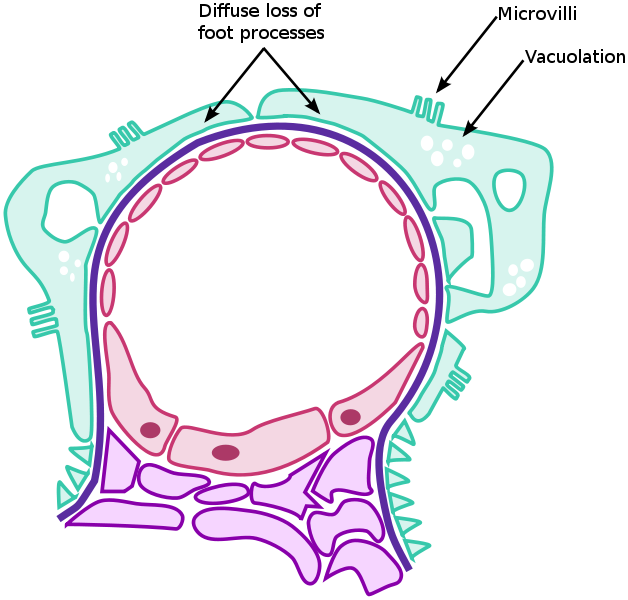Glomerulonephritis, is a renal disease (usually of both kidneys) characterized by inflammation of the glomeruli, or small blood vessels in the kidneys.
It may present with isolated hematuria and/or proteinuria.
Presenting picture can be nephrotic syndrome, a nephritic syndrome, acute renal failure, or chronic renal failure.
Broadly grouped into non-proliferative or proliferative types.
Diagnosing the pattern of GN is important because the outcome and treatment differs in different types.
Primary causes are ones which are intrinsic to the kidney, whilst secondary causes are associated with certain infections (bacterial, viral or parasitic pathogens), drugs, systemic disorders (SLE, vasculitis) or diabetes.
Non Proliferative
This is characterised by the numbers of cells (lack of hypercellularity) in the glomeruli. They usually cause nephrotic syndrome. This has the following types:
Minimal change GN (also known as Minimal Change Disease)
The three hallmarks of Minimal Change Disease: diffuse loss of podocyte foot processes, vacuolation, and the appearance of microvilli.
This form of GN causes >75% of nephrotic syndrome in children, but only ~20% in adults. There are no changes visible on simple light microscopy, but on electron microscopy there is fusion of podocytes (supportive cells in the glomerulus).
Immunohistochemistry staining is negative.
Treatment consists of supportive care for the massive edema and as well as steroids to halt the disease process (typically Prednisone 1 mg/kg). Over 90% of children respond well to steroids, being essentially cured after 3 months of treatment.
Adults have a lower response rate (80%).
Failure to respond to steroids ('steroid resistant') or return of the disease when steroids are stopped ('steroid dependent') may require cytotoxic therapy (such as cyclosporin) which is associated with many side-effects.
Other 2 typs with nonproliferative are Focal Segmental GN and Membranous glomerulonephritis.
Proliferative Glomerulonephritis
This type is characterised by increased number of cells in the glomerulus (hypercellular). Usually present as a nephritic syndrome and usually progress to end-stage renal failure (ESRF) over weeks to years (depending on type).
Courtesy: http://en.wikipedia.org/wiki/Minimal_change_disease and Mayo Clinic


No comments:
Post a Comment